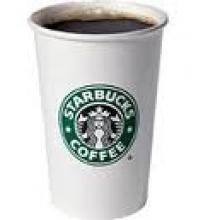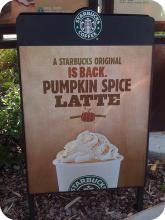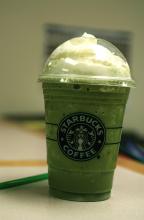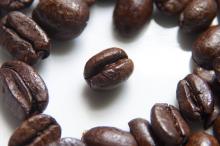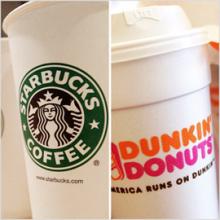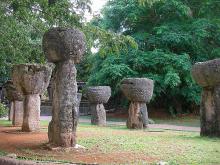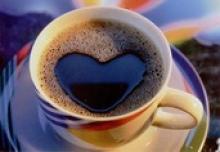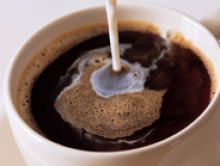Welcome to Pumpkin Spice Latte Season!
The pumpkin spice latte is followed by the gingerbread latte that hits around Thanksgiving. I don't care for the gingerbread latte nearly as much, even though they are practically identical. The pumpkin spice latte has a better balance between spicy and sweet, while the gingerbread latte is a little too "artificial" tasting for my liking.
There's a recipe making the rounds in blogdom today, for you to make your own pumpkin spice latte. I appreciate the effort, but I won't be doing this any time soon. For one thing, lattes are for me a special budgetary treat. I buy one a month, at the very most. It's not just my daily coffee drink. At that rate, I can afford the extra 50 cents or whatever to have Starbucks make it for me.
For another thing, as with most other "make it yourself at home" recipes, it isn't really the same thing. It contains no HFCS, and is vegan, both of which are important considerations to the recipe writer. (Not to me personally, but I respect that point of view.)
The recipe begins with brewed coffee, which is all kinds of wrong if you want a latte. And it includes a considerable amount of actual pumpkin puree, which sort of makes me gag a little to contemplate. (I have a "thing" about food textures, and pumpkin puree whipped into heated milk is definitely on the wrong side of the line.)
More prosaically, you can of course simply buy a bottle of Torani pumpkin spice syrup, since that's pretty much what Starbucks is using.
The pumpkin spice latte is also causing some controversy on another blog, where commenters are vigorously debating whether or not it's "unmanly" for a man to order one. Personally I have much better things to do than police the boundaries of someone else's masculinity. I say if you want a pumpkin spice latte, then you should order one, and to hell what anyone else says!
Ode to the Green Tea Frappuccino
The green tea Frappuccino is made on the "crème" base, which is the non-coffee-flavored one. Typically this gets used for strawberries and crème, and other options suitable for children, those who don't drink caffeine, and other people who for whatever reason want a milkshake and decide to go to Starbucks to buy it.
However, the green tea Frappuccino adds matcha green tea to that base, which gives it a decent caffeine kick. (Although not as strong a kick as when you add a shot of espresso to a regular Frappuccino, which is what I usually do with the coffee-flavored drinks. Adds a great taste and a lot of caffeine for a small additional cost. Down side: it makes the drink thaw and separate faster.)
The matcha green tea is also a little on the harsh side, as far as green tea taste goes. And that, in a Frappuccino, is a good thing. I wouldn't want to try and drink the Tazo matcha green tea straight. It's extremely astringent, with strong grassy notes. But when you pair it with the otherwise overwhelming sweetness of the crème base and a whipped cream topping? Delicious!
Starbucks doesn't release statistics on their drinks, but I would be willing to bet that the green tea Frappuccino is one of their worst sellers. Americans do not generally appreciate green tea flavors straight up, as a rule. (We like our green tea flavors to be vague, just the barest nod to green tea-ness.) And these green tea flavors are unusually robust.
I suspect a lot of people may be turned off by the color. I myself adore the color. Frankly, if the green tea Frappuccino was some other color, like beige or brown, I'm not sure if I would like it as much. It isn't the color of green tea (which is very pale). Instead, it's a Martha Stewart shade of pear green, a perfect summertime shade of leafy green. The dollop of bright white whipped cream on top is the perfect color accent.
Visually speaking, the only down side to this Frappuccino is the same problem with all of them. When you get to the bottom, the whipped cream slops around with the melted remains, and the whole thing gets sticky and gross.
Coffee May Protect Against Skin Cancer
Having an addictive personality sometimes gets me into trouble. I've been known to do nothing but play one video game for days on end. There are a number of websites I can't go a day without checking. And, like many people, I'm pretty much useless without a hefty wallop of coffee each morning. If I don't have time to load a pot into my body, I become a stiff, cranky mess who hates sunlight and kittens and all things good in the world. I know some people who aren't real people on a given day until they've gone for a run or eaten, but coffee is my own real human on switch. It isn't just the caffeine, although that's obviously what's got me hooked. I couldn't do a daily Red Bull or pill. I like the ritual of it, the hot water, the smell, the taste. Luckily for me, it turns out my addiction may have a few more health benefits than most.
"Addiction" is a weighty word, especially when it comes to health. Cigarettes are obviously a no-go when it comes to taking care of your body. Same with alcohol, to say nothing of the unseemlier habit-forming drugs. The health effects of coffee have long been debated. Some praise its antioxidants, while others assert that nothing that makes you feel that good could possibly be good for you. It does contain some nasty oily components that need to be filtered out, and some of its chemicals have been shown to be carcinogenic in rodents. It's also pretty acidic and can be harsh on the digestive system, especially if you've already got some malfunction in there. And drinking too much of it can make for an unsightly system shock. On the other hand, it improves mental functions--and new studies show evidence that it may actually reduce the risk of cancer in humans.
Well, possibly. Researchers at Rutgers University are looking into the way caffeine fights UV damage to skin. A recently completed study shows that caffeine inhibits a protein enzyme called ATR in the skin. Apparently the activity of ATR upon exposure to UV rays can lead to skin cancer. With the protein disabled by caffeine, the risk of cancer goes down. The study had a group of mice drink caffeinated water, then exposed them to UVB radiation. The caffeinated mice were able to kill off their damaged cells more effectively and stave off cancer growth.
While the study's not entirely conclusive on whether drinking coffee will definitely prevent cancer, it does seem as though the presence of caffeine in the body gives your skin an edge in dealing with sun-related cell damage. The study suggests that topically applied caffeine might be better protection than the ingested kind. Of course, using sunscreen to block UV rays is probably your best protection right now, unless you really feel like bathing in coffee to test its anti-carcinogenic properties (probably not the most cost-effective way to shield your skin from sunshine). Still, it's nice to know my old standby legal drug is good for more than just kickstarting my brain into high gear every morning.
NYC Starbucks Cuts Off Perma-Loungers
Many Starbucks stores offer the perfect atmosphere for summer lounging. There's air conditioning, over-sugared icy beverages, plush chairs, a bland soundtrack, and free internet. What more could your average bored upper-middle-class city dweller want out of a business? The only problem Starbucks faces now is that their customers just won't leave. They've made it too comfortable for people and now they're sticking around all day.
So what's a corporate coffee chain to do? Subtly edge them out by cutting off their power source, of course. NYC Starbucks have started covering up electrical outlets with metal plates in the hopes that campers will edge out when their laptop batteries die. Passive aggressive? Sure, but somebody's got to rotate the bourgeois bohemians. It's good for the air quality.
I've seen local coffee shops solve the problem of the lounger by offering just one hour of free wi-fi, after which the customer has to pay per hour. I think that's a little bit more of a sensible solution. Instead of forcing shifts on their clientele, they're just saying, "if you're going to live here, you've got to pay rent." Besides, the dedicated New York City loungers will just bring their iPads or super-souped batteries along with them and continue to check Twitter for five hours straight. Cute move, Starbucks, but I think you underestimate the determination of the average 20-something who just wants to drink expensive coffee drinks and do nothing all day. These kids are committed to their indolence. They will fill up your cloned coffeeshop with their bratty ennui. Just you try and stop them.
Corporate Coffee Culture: Starbucks vs. Dunkin' Donuts
No matter where you wander in this country, you're offered a binary choice of corporate coffee suppliers. Fly into any airport and you'll see the familiar dark green of Starbucks and the vivid orange and purple of Dunkin' Donuts. The colors and graphics are so recognizable we don't even need to see the names anymore; Starbucks recently redesigned its logo to feature only the iconic muse graphic in their signature green. They're everywhere, in every city, busily offering the illusion of choice and freedom to consumers of caffeine. Like Coke and Pepsi, they provide two sides of the same coin: they're both huge companies selling average coffee and reaping enormous profits.
As a New Englander, born and bred, I have a special place for Dunkin' Donuts. They're the only coffeeshop where I can walk in and get what I want with a two word order: "medium regular" (in Boston, "regular" is always code for cream and sugar). A Bostoner panics when she can't see at least two Dunkin' Donuts at any given time. But the Starbucks are just as populous, just as likely to inspire panic when absent. In fact, it was Starbucks and their syrupy espresso concoctions that got me hooked on caffeine to begin with. As my taste matured, I started moving over to Dunkin' for their drip coffee, which tastes less like it was scorched on the floor of the rainforest for two months before brewed.
Despite my preference for independent businesses and small-scale coffee houses, I find myself frequenting Dunkin' more than I'd like to admit. I think I'm starting to realize why. Even though it's a corporate giant, it's far more honest about its capitalistic endeavors than Starbucks ever has been. I can't even drive by a Starbucks anymore without feeling a tiny surge of rage, and here's why: they attempt to co-opt the indie coffee house atmosphere on a scale of ridiculous magnitude. The dim lights, the music, the earth-friendly materials, the fairly-traded coffee--these all serve as mechanisms for making yuppies feel better about themselves when dropping four bucks on a latte. It replicates a sense of culture, of authenticity, when it fact you can walk into any Starbucks and take in the exact same fake culture any day of the year. It's a mere shadow of what makes good coffee shops good, a shallow replication of the getaway of those whose creativity tends to be fueled by caffeine.
Starbucks's shallow attempts at activism enfuriate me as well. They're wrapped up in the culture of the yuppie; it's okay for you to indulge as long as somebody somewhere benefits a little bit as well. Their Ethos water is the most obvious example of this moral-mongering. Starbucks donates five cents of the proceeds from a bottle of Ethos to securing clean water for people in third world countries. Five cents of a two dollar bottle of tap water goes to doing good. Where, exactly, are the other cents going? Certainly not to the free water or the cheap plastic encasing it. The gall of labeling a commercial brand "Ethos" just because a sliver of the proceeds might go somewhere good astounds me. What's worse is that people buy it. That's all they need to believe they're doing good with their money--to send a nickel to the cause. Just one nickel. It makes me so mad.
Dunkin' Donuts may be corporate coffee, but at least it's honest about itself with its customers. It's friendlier than the pseudo-intellectual brainwashers that manage to remain its competition. And for that reason, when I go corporate, I go Dunkin'. I'll take fluorescent lights and orange walls over false culture and pretension any day of the week.
Iced Coffee Makers! Squee!
I’ve been trying to (and miserably failing at) make a decent iced coffee at home for years. It’s just not as good when you make it hot and then chill it—not to mention, you have to be extremely patient to wait for it to chill and then drink it. I’ve always wanted an iced coffee maker but never saw one avaialble.
Until now!
I was browsing through those stupid, wasteful store inserts we get each week when I saw one and gasped. Could it be?
It turns out that you can find iced coffee makers pretty much anywhere you look. And why shouldn’t you? If it’s available in a place like McDonald’s, then it should totally be available for you to make at home, for sure.
If you’re in the market for an iced coffee maker, just search for one online and see what you can find. I haven’t bought one yet and can’t vouch for any particular brand, but once I do, you can bet I’ll be one happy camper.
Latte Stones: Guam's Mystery
The classic Latte Stone is a tall cylinder of stone, capped with a stone hemisphere. Imagine cutting a tennis ball in half and sticking it atop an empty paper towel roll, round side down, and you have the basic shape. They vary in size from only a few feet tall, to the tallest which is 25 feet tall.
Latte Stones were built from approximately 800 AD until the beginning of the era of Spanish colonization, in 1520 AD and later. One of the many mysteries surrounding these stones is how they were put in place, with only human power and little in the way of infrastructure or earthmoving equipment.
The Chamorran people, who are native to the island of Guam, have the answer to that question: according to their legends, the Latte Stones were moved into place by the Taotaomona, the spirits of the dead. The Taotaomona are extremely strong, which allows them to move massive stones around without assistance.
The Taotaomona are understandably protective of the Latte Stones. Anyone who disturbs a Latte Stone will raise the wrath of these ancestral spirits, who will enact their revenge come nightfall.
There are several theories on the Latte Stones' original purpose. They are usually found in pairs, placed in a rectangular shape. The more pairs of Latte Stones, the taller they tend to be. This indicates to many people that they had something to do with architecture. The Latte Stones may have served as support beams for an elevated longhouse-like structure, or they may have been holding up the ceiling of an open-air shelter. The idea being that the longer the building, the taller it was, and that this signified status.
One problem with this theory is that the earliest travelers to Guam never observed people living in structures created from Latte Stones. Instead, they lived on the ground, inside thatched huts and lean-tos. Archaeologists have also failed to find the expected signs of human occupancy (including broken tools, cookware, and other items) among the Latte Stones.
The architectural theories continue with the theory that they may have served as shelters for proas, which is a sort of catamaran that was developed in Micronesia. Proas were important vessels both for travel and for fishing, and they were highly valued in their communities. In an area with rainfall as abundant as that of Micronesia, the need to shelter a vessel during bad weather is crucial.
Others believe that the Latte Stones were used to create a sort of cemetery. This is based on finding bodies buried near many pairs of Latte Stones. Latte Stones are associated with burials particularly along the coastline, and less so in the interior of the island.
Despite - or perhaps because of - the persistent mystery, the Latte Stone has become the unofficial symbol of Guam. The familiar shapes can be found being used as icons throughout Guam, and the Chamorro people are proud of their heritage.
Photo credit: Flickr/jetalone
Drink Up Fellas! Coffee Found to Reduce Instances of Lethal Prostate Cancer
In a recent study released by the Journal of the National Cancer Institute, drinking 5-6 cups of coffee a day (roughly my daily regimen) can significantly reduce the occurence of high-risk prostate cancer in men. Although coffee consumption had little correlation to instances of low-risk cancers, including prostate, it spiked significantly with instances of high-risk or lethal prostate cancers. What's even better is that the benefits seem to be linked to the non-caffeine components of coffee because the results were almost identical for decaffeinated coffee consumption.
Prostate cancer is the second leading cause of cancer death for men in the U.S., and the fifth leading cause of death for men overall. According to MedTV.com, 2 million men in this country have a history with prostate cancer, particularly those over 55, and roughly 23,000 die per year of it. There are very few preventative avenues open for men that are specific to this cancer, other than the common nutritional and exercise advice we get from all physicians regarding all physical ailments. This breakthrough may allow scientists to target the specific coffee components and derive medicines form them.
What are the implications of 125 million American men suddenly guzzling 6 cups of coffee everyday? Massive increases in work productivity? Probably not, and if they were smart they would only do the recommended ONE cup of caffeinated coffee and switch to decaf for the rest of their prostate-health coffee intake. However, the non-caffeine antioxidants and other elements in coffee have been linked to everything from lowering one's chances for heart disease to increasing one's base sex drive.
So, along with your two glasses of red wine for heart health, your pack of cards-sized dollop of protein for digestion, your oatmeal, yogurt, wheat grass, and eggs (wait, are those bad again?) managing means by scientific study could be an exhaustive process. I take this most recent study with a grain of salt (and a cup of coffee). Afterall, evidence is just evidence, but if it justifies my otherwise excessive intake of coffee each morning, I'll take it. Now if they could just find scientific evidence that 5-6 beers a night staves off Alzheimers...
Photo from sustainablog.org
Late Latte
The ingredients you need to make a Late Latte are the same as a regular one: Milk and Dark Roast Espresso Coffee (or "regular" coffee). I happen to like equal parts of each but you can decide what you like best depending on your own preferences.
To make:
Heat milk in a saucepan while you whisk to create foam.
Brew coffee (or Dark Roast Espresso Coffee) and combine the two.
Sweeten with sugar if you like.
Easy right?
Try it out - maybe you, too, will become a fan of the Late Latte.
